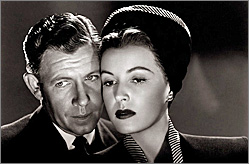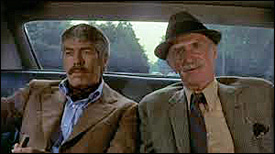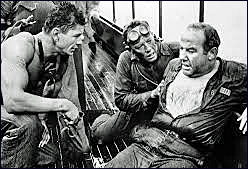Thu 8 Jun 2017
A Made for British TV Movie Review by Dan Stumpf: THE ANATOMIST (1956).
Posted by Steve under Crime Films , Reviews[3] Comments
THE ANATOMIST. Made for British TV: A Towers of London Production, 06 February 1956. Televised as part of the series ITV Play of the Week. US release, 1961.Alastair Sim, George Cole, Adrienne Corri, Jill Bennett and Michael Ripper. Written by James Bridie (play) and Harry Alan Towers. Directed by Dennis Vance.
Perhaps the oddest film ever made about the Burke and Hare thing. Which is not to say it’s any good; this is, in fact, a rather dullish film about body-snatching, murder, riots and young love — but there’s no denying it’s a strange one.
We open in a stylish drawing room where medical student George Cole (Alastair Sims’ perennial side-kick) is explaining to fiancée Jill Bennett why he has to stay in Edinburgh and study under the great Dr. Knox, instead of setting up practice and marrying her. In due course Dr Knox himself appears, played by Mr Sim himself (surprise!) and a lively discussion ensues about the merits of medicine and marriage.
It’s refreshingly outré to see the redoubtable Alastair Sim turn his comic gifts to serious, borderline-sinister effect, but the novelty wears off as the characters keep talking… and talking… and talking… and…
You get the point? The writers and director keep everyone wandering around one crummy set throwing dialogue at each other for about 15 or 20 minutes that seem much longer. Finally though, we get out of the drawing room and into a sleazy pub, where Burke and Hare (Hare is played by Michael Ripper, who would soon become a regular in Hammer films) start cozening a lady of easy virtue and ill repute (Adrienne Corri) plying her with strong drink and sweet words. And more words… and more words… and more….
Suffice it to say that by the time they got her out of there, I was ready for any sort of action, though I would have preferred that mayhem be committed on the makers of this thing.
And so it goes. Cole recognizes Ms. Corri’s corpse in Sim’s lecture hall and they discuss the matter till it’s talked to death. The scene shifts (restlessly) back to Bennett’s drawing room where someone tells us about Burke’s trial and the ensuing riots, just in time for the remainder of the cast to debate the proprieties of the situation. And then…
Well, dull as it is, I’m not going to give away the ending of this thing except to say it was a merciful release and even a bit of a surprise, not that I cared much by that point. The Anatomist takes an unusual view of the whole body-snatching business (though to be strictly accurate, neither Burke nor Hare ever snatched any bodies) and it’s always a pleasure to see Alastair Sim strut his stuff.
But I would have preferred less strutting and more movement.


